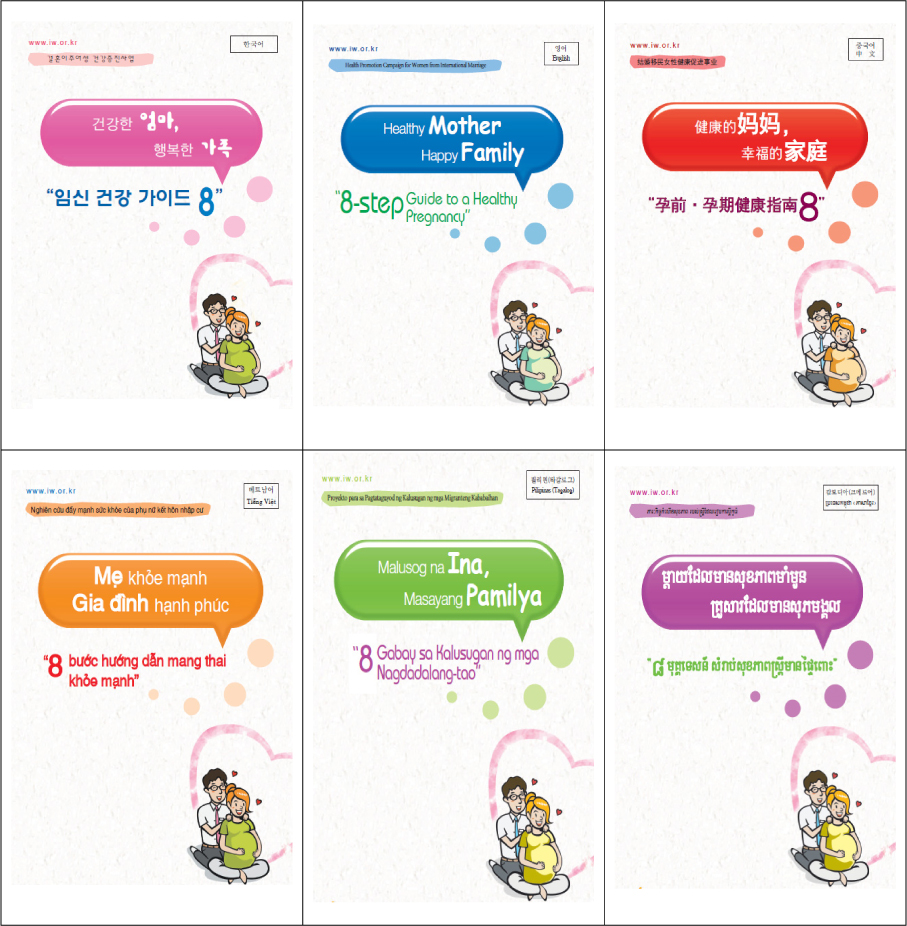Korean J Women Health Nurs.
2014 Dec;20(4):235-245. 10.4069/kjwhn.2014.20.4.235.
Development and Evaluation of Multilingual Education Materials to Promote Immigrant Women's Adaptation to Pregnancy
- Affiliations
-
- 1Department of Nursing, Daegu Haany University, Daegu, Korea.
- 2Department of Nursing, Baekseok University, Cheonan, Korea.
- 3Division of Nursing, Hallym University, Chuncheon, Korea. ghjeong@hallym.ac.kr
- KMID: 2308157
- DOI: http://doi.org/10.4069/kjwhn.2014.20.4.235
Abstract
- PURPOSE
This study was done to develop and evaluate multilingual education materials to promote health and adaptation to pregnancy for immigrant women in Korea.
METHODS
This study had three procedures: First, contents of the education materials were developed according to pregnant women's needs, literature reviews, and group discussion. Details in contents were constructed based on Roy's adaptation model; Second, validity verification and translation of education materials were accomplished; Third, evaluation of the education materials was done through a survey of immigrant women.
RESULTS
The education materials were developed in six languages (Korean, English, Chinese, Vietnamese, Filipino, and Cambodian). The title is "Healthy mother, happy family: eight-step guide to a healthy pregnancy". It was composed of an eight-step guide to healthy pregnancy, self-examination check list, websites for childbirth education and information, and guidelines on education materials in a brochure. In the evaluation, the average response score for the questionnaire items was high (3.23 on a four-point Likert scale). The average score for Cambodian immigrants was the highest of all immigrant women.
CONCLUSION
Multilingual education materials developed in this research will help community health nurses to manage pregnancies for immigrant women and will be useful for health education for these women.
MeSH Terms
Figure
Cited by 2 articles
-
Adaptation in pregnant women: a descriptive phenomenological study using Giorgi’s approach
Minseon Koh, Jisoon Kim, Sukhee Ahn
Korean J Women Health Nurs. 2020;26(4):346-357. doi: 10.4069/kjwhn.2020.11.26.Comparison of the number of live births, maternal age at childbirth, and weight of live births between Korean women and immigrant women in 2018
Sun-Hee Kim, Sooyoung Kim, Byeongje Park, Seokmin Lee, Sanghee Park, Geum Hee Jeong, Kyung Won Kim, Sook Jung Kang
Korean J Women Health Nurs. 2021;27(1):40-48. doi: 10.4069/kjwhn.2021.03.15.
Reference
-
1. Statics Korea. Marriage rate for Korean men and foreign women; population movement study in 2005 [Internet]. Seoul: Statistics Korea;2006. cited 2014 August 12. Available from http://kostat.go.kr.2. Statics Korea. International migration statistics 2013 [Internet]. Seoul: Statistics Korea;2014. cited 2014 August 12. Available from http://www.index.go.kr/potal/main/EachDtlPageDetail.do?idx_cd=2430.3. Kim HR, Hwang NM, Chang IS, Yoon KJ, Kang BJ. The reproductive health and policy subject in the international foreign wives. Seoul: Korea Institute for Health and Social Affairs;2008.4. Jeong GH, Koh HJ, Kim KS, Kim SH, Kim JH, Park HS, et al. A survey on health management of during pregnancy, childbirth, and the postpartum of immigrant women in a multi-cultural family. Korean J Women Health Nurs. 2009; 15(4):261–269.
Article5. Ham U, Kim JY. Method of Korean language education for married immigrant women through story expression. J Korean Lang Educ. 2011; 22(2):351–373.6. Kim YS, Heo S, Nguyen TA. Language, education; A study on the expression class through story-telling about interracial married womens homeland cultures. Cross Cult Stud. 2011; 25:695–721.7. Yang MJ. The study on Korean culture education plan for immigrant women utilizing historical tale-focusing stories of wealth acquisition and stories of success. J Int Area Stud. 2010; 14(3):283–302.8. Kim KW. Pregnancy and childbirth experiences of immigrant women in a multi-cultural family. J Korean Soc Matern Child Health. 2010; 14(2):133–144.9. Ricci SS. Essential of maternity, newborn, & women's health nursing. 2nd ed. Philadelphia: Lippincott Williams & Wilkins;2009.10. Nam WH. Multicultural families. Seoul: Jangshewon;2010.11. Roy SC. Introduction to Nursing: An adaptation model. 2nd ed. Englewood Cliffs: Prentice Hall Inc.;1984.12. Seol DH, Kim HS, Yoon HS, Lee HK, Yim KT, Chung KS, et al. Foreign wives' life in Korea: Focusing on the policy of welfare and health. Seoul: Ministry of Health and Welfare;2005.13. Yang SO, Jeong GH. Development and application of evaluation tool for sexual education materials. Korean J Child Health Nurs. 2003; 9(4):408–419.14. Jeong GH, Kim KW, Bae KE. Depression and family function of immigrant women in Korea. J Korean Soc Matern Child Health. 2012; 16(2):157–169.15. Lee EO, Im NY, Park HY. Nursing medical research and statics analysis. Seoul: Soomoonsa;1999.16. Jeon MS, Kang KJ, Park SH. A study on pregnancy, delivery and infant rearing knowledge and education need of marriage immigrant women. J Agric Med Community Health. 2011; 36(3):179–190.17. Kim MY, Koh HJ. A study about intermarriage foreign wives prenatal education needs, health belief and prenatal care compliance. Keimyung J Nurs Sci. 2008; 12(1):83–96.18. Roy SC, Andrews HA. The Roy adaptation model. 2nd ed. Stamford: Appleton & Lange;1999.19. Sercekus P, Mete S. Effects of antenatal education on maternal prenatal and postpartum adaptation. J Adv Nurs. 2010; 66(5):999–1010.20. Kim EH, Lee EJ, Kim MJ, Park DY, Lee SH. Effects of an education program of pregnancy and delivery on pregnancy related knowledge, newborn care knowledge, and postpartum care self-efficacy of marriage immigrant women. J Korean Acad Adult Nurs. 2010; 40(1):78–87.
- Full Text Links
- Actions
-
Cited
- CITED
-
- Close
- Share
- Similar articles
-
- Development of a Scale to Assess Immigrant Women's Needs for Pregnancy and Postpartum Adaptation
- Comparison of Needs for Pregnancy and Postpartum Adaptation of Chinese Immigrant Women and Vietnamese Immigrant Women in South Korea
- Effects of an Educational Program of Pregnancy and Delivery on Pregnancy related Knowledge, Newborn Care Knowledge, and Postpartum Care Self-efficacy of Marriage Immigrant Women
- Moderating Effect of Family Support on the Relationship between Parenting Stress on Depression of Immigrant Women
- Analysis of Intervention Studies for Married Immigrant Women



